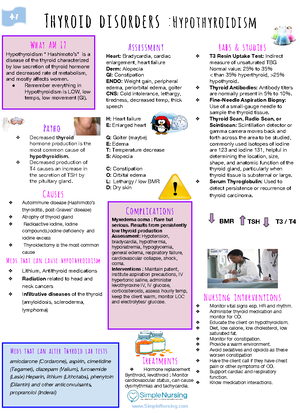- Information
- AI Chat
Was this document helpful?
Cc 8 hemodynamic
Course: Critical Care (408)
18 Documents
Students shared 18 documents in this course
University: Loma Linda University
Was this document helpful?

Arterial Line (A-Line) BP, serial
ABGs, hemo
Pulmonary Artery Line PA Catheter Components
proximal injectate port
(up to 492 mL/hr. no
titratable meds)
measure CO (4-6 L/min)
measure CVP (2-5)
PA distal port (NO MEDS)
measure PAP (20-
30mmHg/5-10mmHg)
balloon inflation port
inflate balloon obtain
PAOP (5-12)
thermistor wire connector
measure CO (4-6) & blood
temperature
CCO connector
measure continuous CCO
SvO2 sensor
measures continuous SvO2
for continuous BP reading & more
Dicrotic Notch
small dip in graph of aortic
pressure throughout cardiac cycle
aortic valve closure
Pulsus Paradoxus
diminished amplitude on
inspiration
SBP drop > 10 mmHg (small
box)
suggestive of cardiac
tamponade, pericarditis, or lung
disease
Pulsus Alternans
regular pattern of amplitude
changes alternate between
stronger & weaker beats
suggestive of end stage left
ventricular heart failure (not
with breathe like paradoxus)
AKA: PA Line, Swan-Ganz, Right
Heart Catheter
PA Catheter Indications
monitor cardiac function (MI,
CHF)
monitor fluid status
assess hemodynamic response to
fluids, diuretics, vasoactive
agents, & inotropes
manage hemodynamic instability
after cardiac surgery
guide treatment of shocks
Gets:
How well pump is pumping, how
full right and left side of heart is,
how well patient’s arteries can
squeeze
Hemodynamic Terms & normal
values
CO – cardiac output
BV pumped by heart in 1min
how well pump is pumping
4-6L/min
CI – cardiac index
CO adjust for body size
how well pump is pumping
2.2 - 4.0L
SV – stroke volume
volume ejected w/ each
heartbeat
60-70mL
SVI – stroke volume index
stroke volume adjusted for
body size
40-50
SVR – systemic vascular
resistance
measures left ventricular
resistance (afterload)
index of arteriolar compliance
or constriction throughout
body
how well pt’s arteries can
squeeze
800-1400 dynes sec/cm5
PVR – pulmonary vascular
resistance
measures right ventricular
resistance (afterload)
100-250
CVP: important to remember
that CVP in isolation is
meaningless
must be
interpreted in conjunction w/
other clinical data (v/s,
heart/lung sounds, &
assessment findings)
Possible cause of increased
CVP:
vasoconstriction
↑ blood volume
right ventricular failure
tricuspid insufficiency
pericardial tamponade
pulmonary embolism
obstructive pulmonary disease
positive pressure ventilation
Decreased CVP may
indicate
hypovolemia
sepsis or vasodilator meds
vasodilation
↑myocardial contractility
CVP – central venous pressure
BP in thoracic vena cava near
the right atrium of heart
CVP reflects amount of blood
returning to heart
right ventricular preload
how full right side of heart is
2-5 mmHg
on ventilator: 7-10 mmHg
PAP – pulmonary artery
pressure
BP in pulmonary artery
20-30mmHg/5-10mmHg
PAOP – pulmonary artery
wedge pressure
left ventricular preload
how full left side of the heart is
5-12 mmHg
SvO2 – mixed venous oxygen
saturation
measures balance between O2
supply & demand at tissue level
O2 supply: Hgb, CO, SaO2
O2 demand: VO2 tissue
metabolism
60-75%
ScvO2 – central venous oxygen
saturation
70-80%
sustained ScvO2 <70%
↑mortality
PA Catheter – Snapshot of
Heart Function
CO & CI – how well pump is
pumping
CVP – how full right side of
heart is
PAOP – how full left side of
heart is
SVR – how well pt’s arteries
can squeeze
Math Formulas Primary Assessment w/ Lines Level & Zero - Prior to
Measurement
level transducer & zero at
phlebostatic axis
CO – cardiac output
CO = SV x HR
is patient stable?
check catheter/line position













